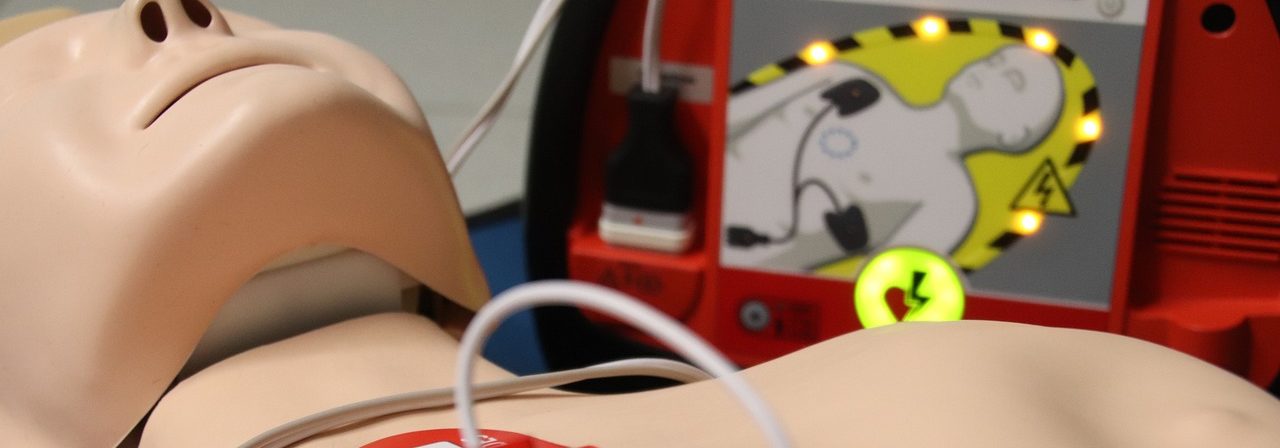
Sudden cardiac arrest (SCA) is a leading cause of death, killing more than 350,000 people each year in the U.S.
Cardiac arrest is when “the bottom chamber of the heart is erratic; it’s not pumping to provide circulation,” says Dr. Monica Lo, cardiac electrophysiologist. “If it stays in that rhythm and it doesn’t come back, the heart stops.”
People in sudden cardiac arrest can be saved with quick intervention using an automated external defibrillator (AED), which has been proven to improve SCA survival rates. In fact, 1,700 people are saved in the U.S. every year by bystanders with an AED.
Unfortunately, most people are not aware of how to react or are hesitant to use an AED though it’s a vital, life-saving skill.
With knowledge and training, anyone can learn to operate an AED safely and effectively.
What is an AED?
The automated external defibrillator is a sophisticated, yet easy to use, electronic medical device designed for use on those experiencing sudden cardiac arrest.
The AED checks a person’s heart rhythm and recognizes if it’s a rhythm that requires a shock.
“With defibrillators, which are nowadays automatic, they tell you exactly what to do so you don’t have to be afraid of it,” Lo said. “It will tell you where to apply the patches and if the rhythm is a shockable rhythm or not, meaning there are some rhythms that you cannot shock to get them back. If it’s a ventricular tachycardia or a ventricular fibrillation rhythm, it delivers a shock to the heart and converts the rhythm into a normal rhythm.”
AEDs do not require a prescription and are available in hospitals, schools, and most public buildings and businesses. Dr. Lo also stresses that sport venues should have a defibrillator close as well as any areas with a high risk of SCA.
Why learn to use an AED?
When a person undergoes cardiac arrest, you should always call 911 first. However, the average response time for first responders is between 8-12 minutes.
For each minute a defibrillation is delayed, the odds of survival are reduced by approximately 10 percent. In fact, if not revived within 10 minutes of collapsing, the victim’s brain damage is typically irreversible.
“If the heart stops and there’s a lack of oxygenation to the brain, then even if somebody regains a pulse, they may not recover neurologically, leading to brain death,” Lo says.
How do you use an AED?
AEDs are very easy to use and almost all modern AEDs offer loud and audible instructions to walk the user through lifesaving CPR and defibrillation.
If you see that someone has fainted and may need an AED, grab the closest AED and do the following:
- Check to see if the person is breathing and has a pulse.
- If you cannot feel a pulse and the person is not breathing, call for emergency help.
- While you are waiting for help, start CPR. If there is someone with you, ask them to find an AED.
- Once you get the AED, turn it on.
- It will give you step-by-step voice instructions.
- Deliver the shock when pads are in place.
- The AED will guide you through CPR when the shock is given.
Arkansas Heart also offers on-site AED training through our community and corporate engagement program. To learn more, email marketing@arheart.com.
How do I get an AED?
AEDs can cost up to $2,800, which can be expensive for some organizations. Thankfully, there are many AED grants available to corporations, nonprofits, communities and more.
Visit these resources to find a grant that’s best for you:
- AED grants program
- AED grants for nonprofits
- AED grants for communities
- American Heart Association AED grants
—-
Sudden cardiac arrest can occur anywhere, anytime to anyone, often without warning. Take your heart health in your own hands and learn your cardiovascular for cardiac arrest, heart attack and stroke risk before it’s too late. You can do that today with our quick and painless Keep the Beat heart screening. Sign up today!
Want to learn more about our patient-centered, specialized cardiac care? Discover our wide range of cardiac care services or ask your primary care provider for a referral today.